Report: Analysis of Communication Barriers at Learn English UK
VerifiedAdded on 2022/12/30
|10
|2285
|36
Report
AI Summary
This report offers a comprehensive analysis of organizational communication, focusing on the challenges faced by Learn English UK. It delves into various communication theories, including formal, informal, oral, written, mass, internal, external, and lateral communication. The report identifies specific barriers at Learn English UK, such as the influence of mother tongue, lack of exposure, difficulty adapting to change, disinterest in the job, and systemic issues. Furthermore, the report provides actionable recommendations to overcome these barriers, including strategies for body language awareness, active listening skills, and verbal communication techniques. The conclusion emphasizes the importance of effective communication for employee performance, organizational goals, and customer satisfaction, highlighting the need for improved communication skills and a reduction in barriers to foster a more productive and collaborative environment. The report also includes references to support the analysis and recommendations.
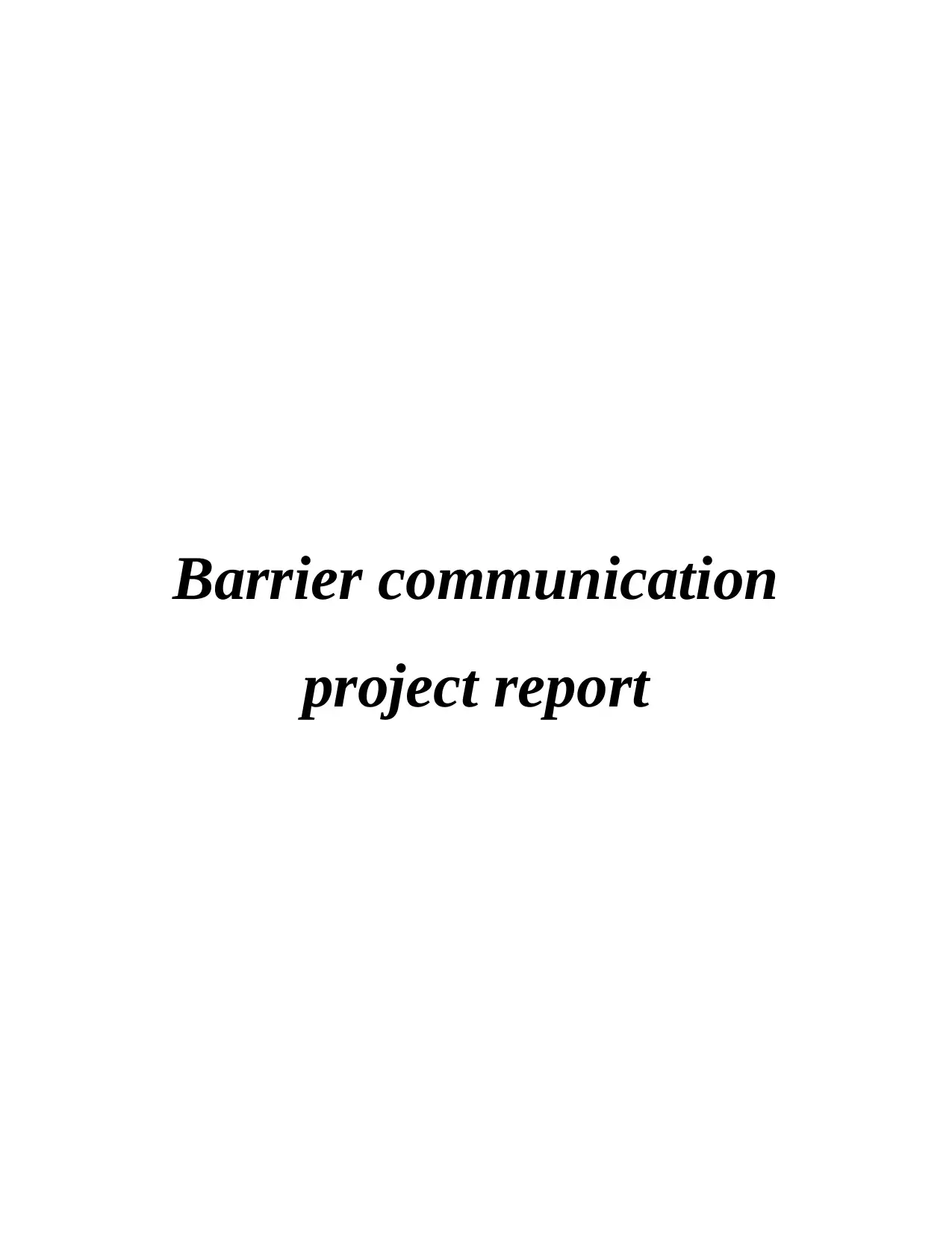
Barrier communication
project report
project report
Paraphrase This Document
Need a fresh take? Get an instant paraphrase of this document with our AI Paraphraser
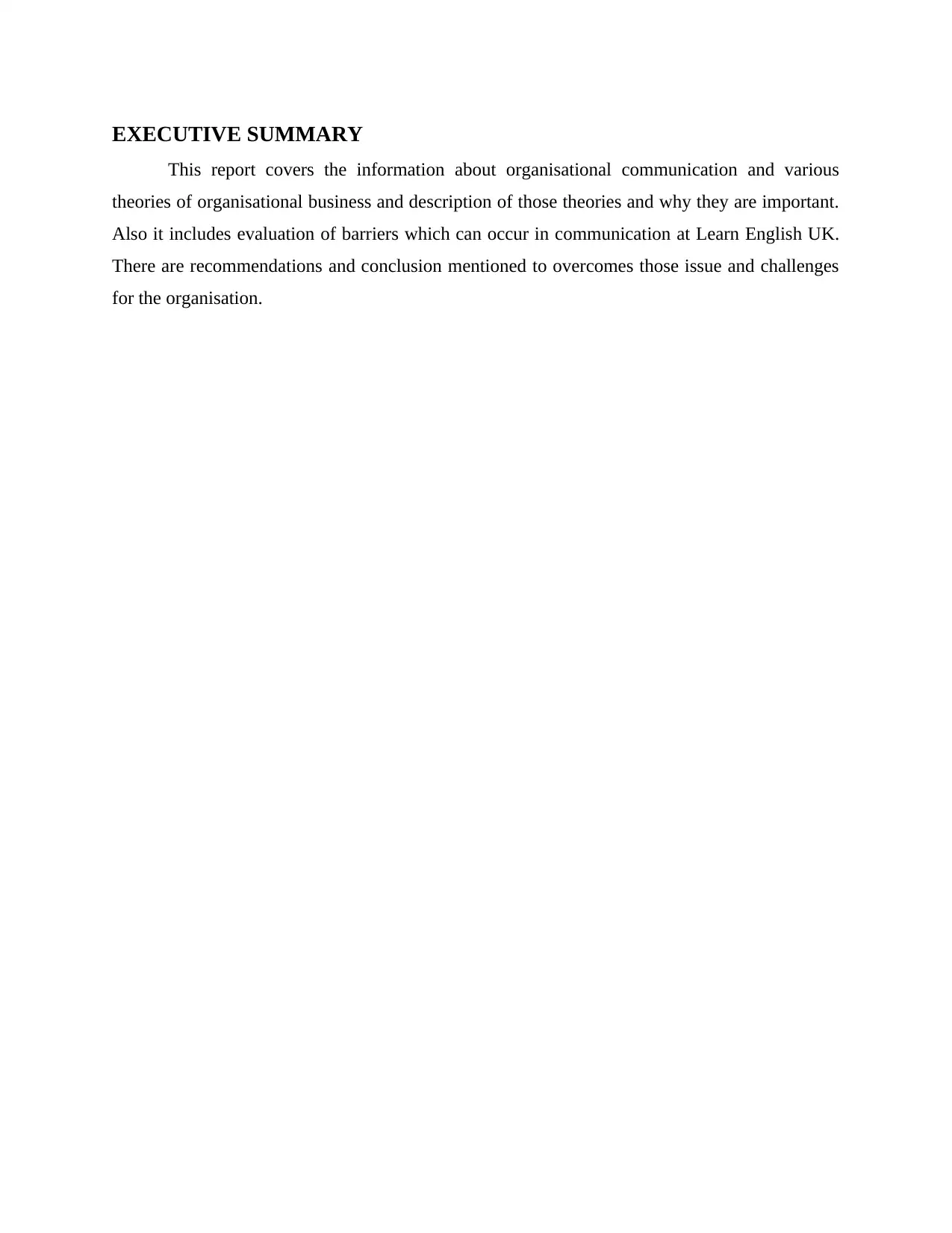
EXECUTIVE SUMMARY
This report covers the information about organisational communication and various
theories of organisational business and description of those theories and why they are important.
Also it includes evaluation of barriers which can occur in communication at Learn English UK.
There are recommendations and conclusion mentioned to overcomes those issue and challenges
for the organisation.
This report covers the information about organisational communication and various
theories of organisational business and description of those theories and why they are important.
Also it includes evaluation of barriers which can occur in communication at Learn English UK.
There are recommendations and conclusion mentioned to overcomes those issue and challenges
for the organisation.
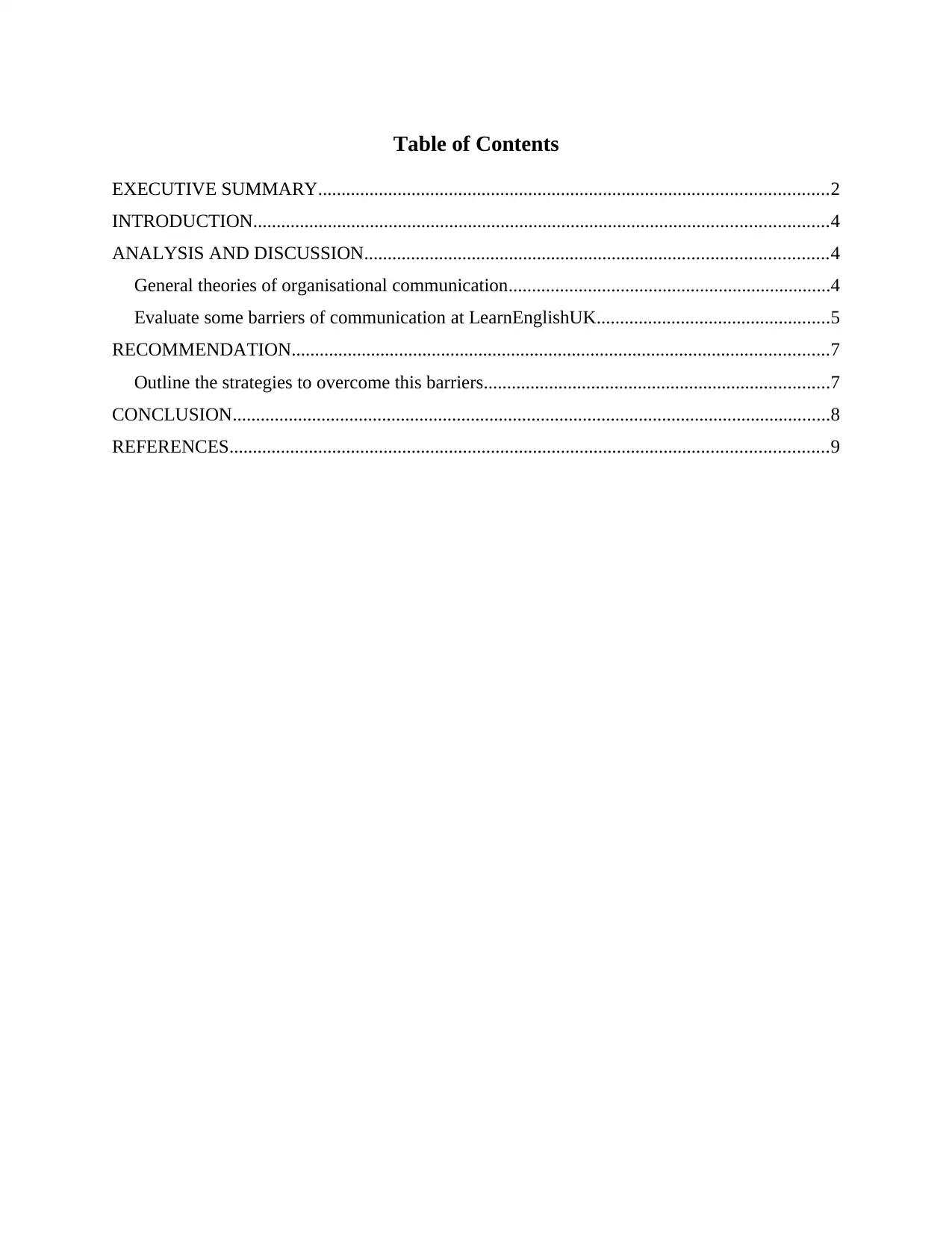
Table of Contents
EXECUTIVE SUMMARY.............................................................................................................2
INTRODUCTION...........................................................................................................................4
ANALYSIS AND DISCUSSION...................................................................................................4
General theories of organisational communication.....................................................................4
Evaluate some barriers of communication at LearnEnglishUK..................................................5
RECOMMENDATION...................................................................................................................7
Outline the strategies to overcome this barriers..........................................................................7
CONCLUSION................................................................................................................................8
REFERENCES................................................................................................................................9
EXECUTIVE SUMMARY.............................................................................................................2
INTRODUCTION...........................................................................................................................4
ANALYSIS AND DISCUSSION...................................................................................................4
General theories of organisational communication.....................................................................4
Evaluate some barriers of communication at LearnEnglishUK..................................................5
RECOMMENDATION...................................................................................................................7
Outline the strategies to overcome this barriers..........................................................................7
CONCLUSION................................................................................................................................8
REFERENCES................................................................................................................................9
⊘ This is a preview!⊘
Do you want full access?
Subscribe today to unlock all pages.

Trusted by 1+ million students worldwide
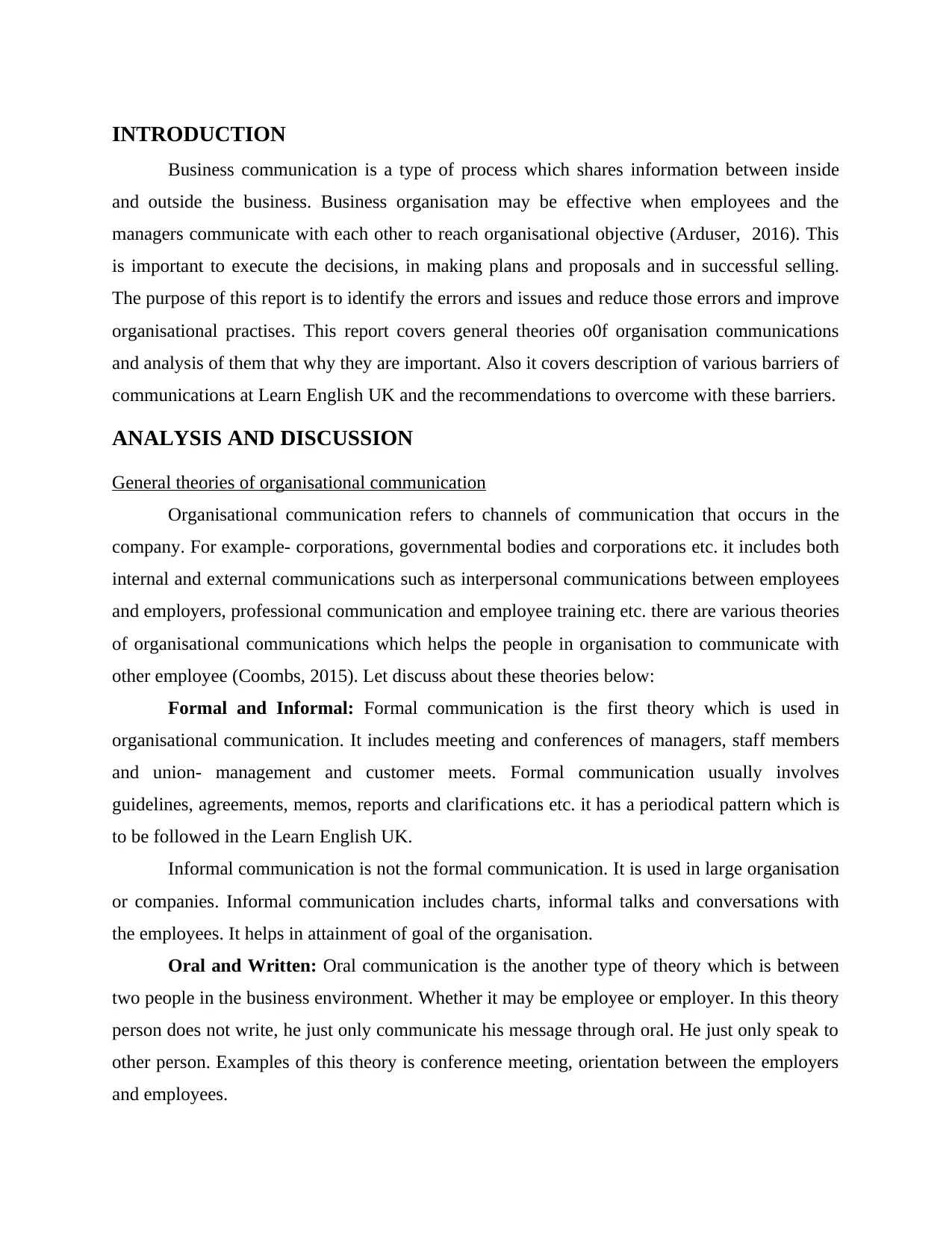
INTRODUCTION
Business communication is a type of process which shares information between inside
and outside the business. Business organisation may be effective when employees and the
managers communicate with each other to reach organisational objective (Arduser, 2016). This
is important to execute the decisions, in making plans and proposals and in successful selling.
The purpose of this report is to identify the errors and issues and reduce those errors and improve
organisational practises. This report covers general theories o0f organisation communications
and analysis of them that why they are important. Also it covers description of various barriers of
communications at Learn English UK and the recommendations to overcome with these barriers.
ANALYSIS AND DISCUSSION
General theories of organisational communication
Organisational communication refers to channels of communication that occurs in the
company. For example- corporations, governmental bodies and corporations etc. it includes both
internal and external communications such as interpersonal communications between employees
and employers, professional communication and employee training etc. there are various theories
of organisational communications which helps the people in organisation to communicate with
other employee (Coombs, 2015). Let discuss about these theories below:
Formal and Informal: Formal communication is the first theory which is used in
organisational communication. It includes meeting and conferences of managers, staff members
and union- management and customer meets. Formal communication usually involves
guidelines, agreements, memos, reports and clarifications etc. it has a periodical pattern which is
to be followed in the Learn English UK.
Informal communication is not the formal communication. It is used in large organisation
or companies. Informal communication includes charts, informal talks and conversations with
the employees. It helps in attainment of goal of the organisation.
Oral and Written: Oral communication is the another type of theory which is between
two people in the business environment. Whether it may be employee or employer. In this theory
person does not write, he just only communicate his message through oral. He just only speak to
other person. Examples of this theory is conference meeting, orientation between the employers
and employees.
Business communication is a type of process which shares information between inside
and outside the business. Business organisation may be effective when employees and the
managers communicate with each other to reach organisational objective (Arduser, 2016). This
is important to execute the decisions, in making plans and proposals and in successful selling.
The purpose of this report is to identify the errors and issues and reduce those errors and improve
organisational practises. This report covers general theories o0f organisation communications
and analysis of them that why they are important. Also it covers description of various barriers of
communications at Learn English UK and the recommendations to overcome with these barriers.
ANALYSIS AND DISCUSSION
General theories of organisational communication
Organisational communication refers to channels of communication that occurs in the
company. For example- corporations, governmental bodies and corporations etc. it includes both
internal and external communications such as interpersonal communications between employees
and employers, professional communication and employee training etc. there are various theories
of organisational communications which helps the people in organisation to communicate with
other employee (Coombs, 2015). Let discuss about these theories below:
Formal and Informal: Formal communication is the first theory which is used in
organisational communication. It includes meeting and conferences of managers, staff members
and union- management and customer meets. Formal communication usually involves
guidelines, agreements, memos, reports and clarifications etc. it has a periodical pattern which is
to be followed in the Learn English UK.
Informal communication is not the formal communication. It is used in large organisation
or companies. Informal communication includes charts, informal talks and conversations with
the employees. It helps in attainment of goal of the organisation.
Oral and Written: Oral communication is the another type of theory which is between
two people in the business environment. Whether it may be employee or employer. In this theory
person does not write, he just only communicate his message through oral. He just only speak to
other person. Examples of this theory is conference meeting, orientation between the employers
and employees.
Paraphrase This Document
Need a fresh take? Get an instant paraphrase of this document with our AI Paraphraser
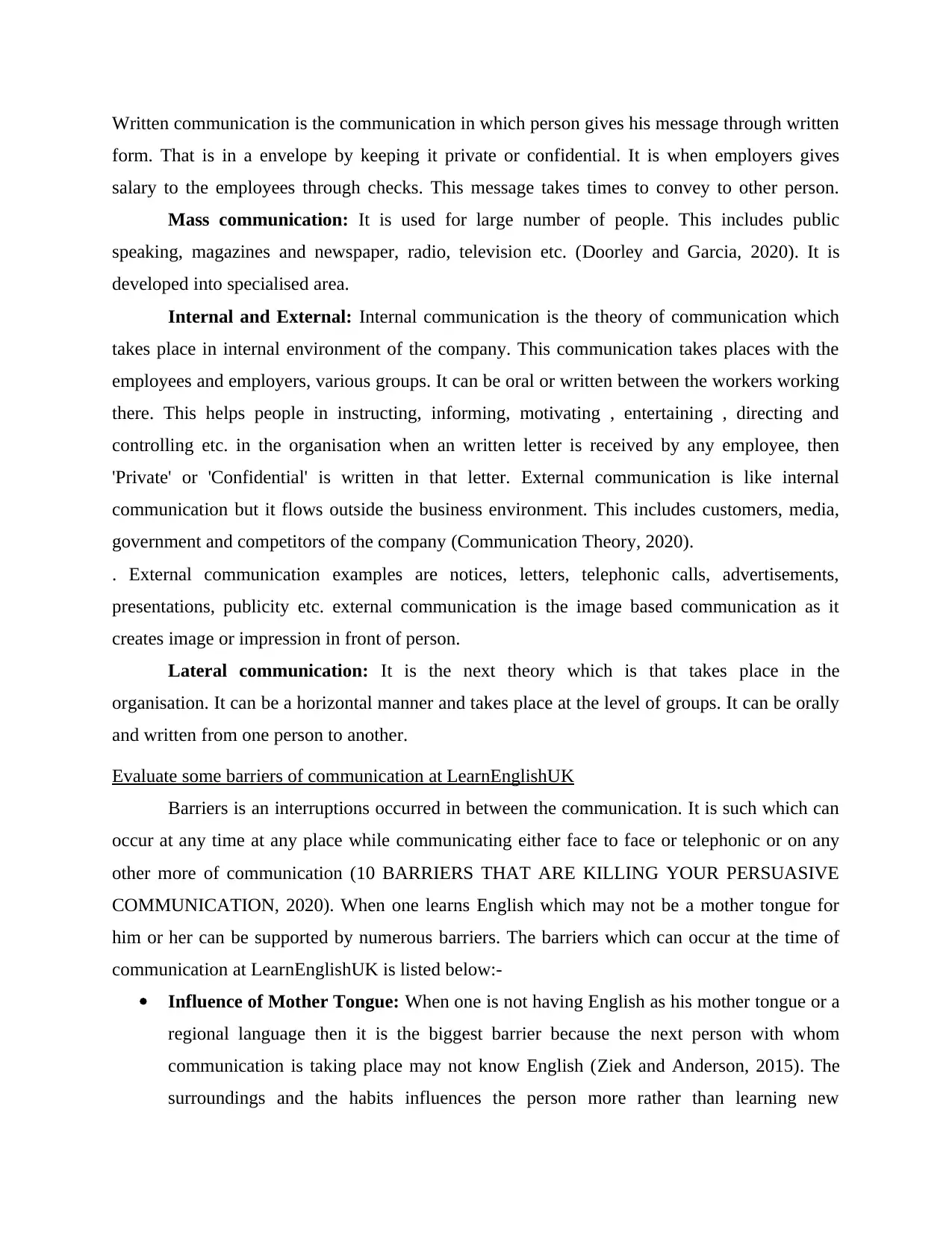
Written communication is the communication in which person gives his message through written
form. That is in a envelope by keeping it private or confidential. It is when employers gives
salary to the employees through checks. This message takes times to convey to other person.
Mass communication: It is used for large number of people. This includes public
speaking, magazines and newspaper, radio, television etc. (Doorley and Garcia, 2020). It is
developed into specialised area.
Internal and External: Internal communication is the theory of communication which
takes place in internal environment of the company. This communication takes places with the
employees and employers, various groups. It can be oral or written between the workers working
there. This helps people in instructing, informing, motivating , entertaining , directing and
controlling etc. in the organisation when an written letter is received by any employee, then
'Private' or 'Confidential' is written in that letter. External communication is like internal
communication but it flows outside the business environment. This includes customers, media,
government and competitors of the company (Communication Theory, 2020).
. External communication examples are notices, letters, telephonic calls, advertisements,
presentations, publicity etc. external communication is the image based communication as it
creates image or impression in front of person.
Lateral communication: It is the next theory which is that takes place in the
organisation. It can be a horizontal manner and takes place at the level of groups. It can be orally
and written from one person to another.
Evaluate some barriers of communication at LearnEnglishUK
Barriers is an interruptions occurred in between the communication. It is such which can
occur at any time at any place while communicating either face to face or telephonic or on any
other more of communication (10 BARRIERS THAT ARE KILLING YOUR PERSUASIVE
COMMUNICATION, 2020). When one learns English which may not be a mother tongue for
him or her can be supported by numerous barriers. The barriers which can occur at the time of
communication at LearnEnglishUK is listed below:-
Influence of Mother Tongue: When one is not having English as his mother tongue or a
regional language then it is the biggest barrier because the next person with whom
communication is taking place may not know English (Ziek and Anderson, 2015). The
surroundings and the habits influences the person more rather than learning new
form. That is in a envelope by keeping it private or confidential. It is when employers gives
salary to the employees through checks. This message takes times to convey to other person.
Mass communication: It is used for large number of people. This includes public
speaking, magazines and newspaper, radio, television etc. (Doorley and Garcia, 2020). It is
developed into specialised area.
Internal and External: Internal communication is the theory of communication which
takes place in internal environment of the company. This communication takes places with the
employees and employers, various groups. It can be oral or written between the workers working
there. This helps people in instructing, informing, motivating , entertaining , directing and
controlling etc. in the organisation when an written letter is received by any employee, then
'Private' or 'Confidential' is written in that letter. External communication is like internal
communication but it flows outside the business environment. This includes customers, media,
government and competitors of the company (Communication Theory, 2020).
. External communication examples are notices, letters, telephonic calls, advertisements,
presentations, publicity etc. external communication is the image based communication as it
creates image or impression in front of person.
Lateral communication: It is the next theory which is that takes place in the
organisation. It can be a horizontal manner and takes place at the level of groups. It can be orally
and written from one person to another.
Evaluate some barriers of communication at LearnEnglishUK
Barriers is an interruptions occurred in between the communication. It is such which can
occur at any time at any place while communicating either face to face or telephonic or on any
other more of communication (10 BARRIERS THAT ARE KILLING YOUR PERSUASIVE
COMMUNICATION, 2020). When one learns English which may not be a mother tongue for
him or her can be supported by numerous barriers. The barriers which can occur at the time of
communication at LearnEnglishUK is listed below:-
Influence of Mother Tongue: When one is not having English as his mother tongue or a
regional language then it is the biggest barrier because the next person with whom
communication is taking place may not know English (Ziek and Anderson, 2015). The
surroundings and the habits influences the person more rather than learning new
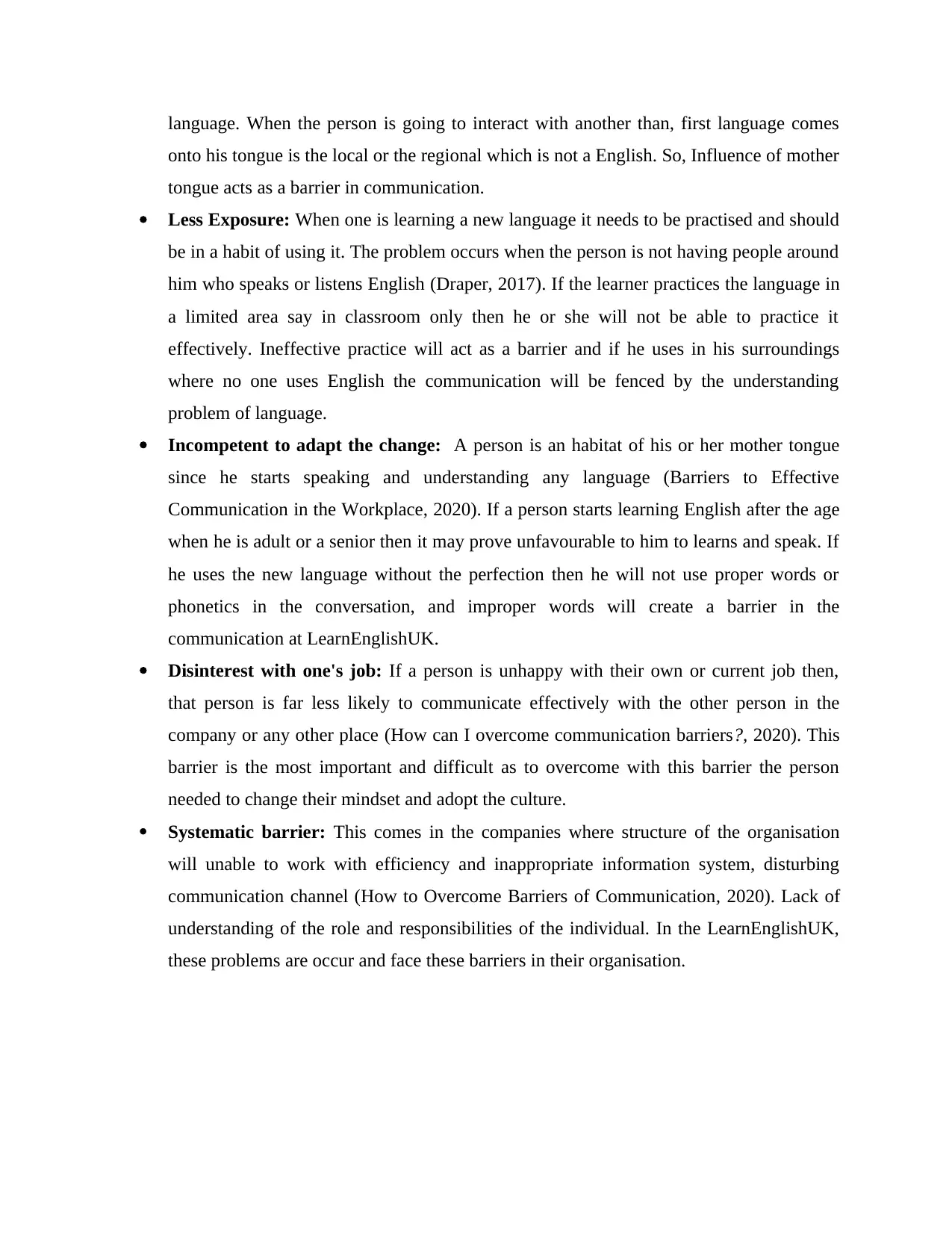
language. When the person is going to interact with another than, first language comes
onto his tongue is the local or the regional which is not a English. So, Influence of mother
tongue acts as a barrier in communication.
Less Exposure: When one is learning a new language it needs to be practised and should
be in a habit of using it. The problem occurs when the person is not having people around
him who speaks or listens English (Draper, 2017). If the learner practices the language in
a limited area say in classroom only then he or she will not be able to practice it
effectively. Ineffective practice will act as a barrier and if he uses in his surroundings
where no one uses English the communication will be fenced by the understanding
problem of language.
Incompetent to adapt the change: A person is an habitat of his or her mother tongue
since he starts speaking and understanding any language (Barriers to Effective
Communication in the Workplace, 2020). If a person starts learning English after the age
when he is adult or a senior then it may prove unfavourable to him to learns and speak. If
he uses the new language without the perfection then he will not use proper words or
phonetics in the conversation, and improper words will create a barrier in the
communication at LearnEnglishUK.
Disinterest with one's job: If a person is unhappy with their own or current job then,
that person is far less likely to communicate effectively with the other person in the
company or any other place (How can I overcome communication barriers?, 2020). This
barrier is the most important and difficult as to overcome with this barrier the person
needed to change their mindset and adopt the culture.
Systematic barrier: This comes in the companies where structure of the organisation
will unable to work with efficiency and inappropriate information system, disturbing
communication channel (How to Overcome Barriers of Communication, 2020). Lack of
understanding of the role and responsibilities of the individual. In the LearnEnglishUK,
these problems are occur and face these barriers in their organisation.
onto his tongue is the local or the regional which is not a English. So, Influence of mother
tongue acts as a barrier in communication.
Less Exposure: When one is learning a new language it needs to be practised and should
be in a habit of using it. The problem occurs when the person is not having people around
him who speaks or listens English (Draper, 2017). If the learner practices the language in
a limited area say in classroom only then he or she will not be able to practice it
effectively. Ineffective practice will act as a barrier and if he uses in his surroundings
where no one uses English the communication will be fenced by the understanding
problem of language.
Incompetent to adapt the change: A person is an habitat of his or her mother tongue
since he starts speaking and understanding any language (Barriers to Effective
Communication in the Workplace, 2020). If a person starts learning English after the age
when he is adult or a senior then it may prove unfavourable to him to learns and speak. If
he uses the new language without the perfection then he will not use proper words or
phonetics in the conversation, and improper words will create a barrier in the
communication at LearnEnglishUK.
Disinterest with one's job: If a person is unhappy with their own or current job then,
that person is far less likely to communicate effectively with the other person in the
company or any other place (How can I overcome communication barriers?, 2020). This
barrier is the most important and difficult as to overcome with this barrier the person
needed to change their mindset and adopt the culture.
Systematic barrier: This comes in the companies where structure of the organisation
will unable to work with efficiency and inappropriate information system, disturbing
communication channel (How to Overcome Barriers of Communication, 2020). Lack of
understanding of the role and responsibilities of the individual. In the LearnEnglishUK,
these problems are occur and face these barriers in their organisation.
⊘ This is a preview!⊘
Do you want full access?
Subscribe today to unlock all pages.

Trusted by 1+ million students worldwide
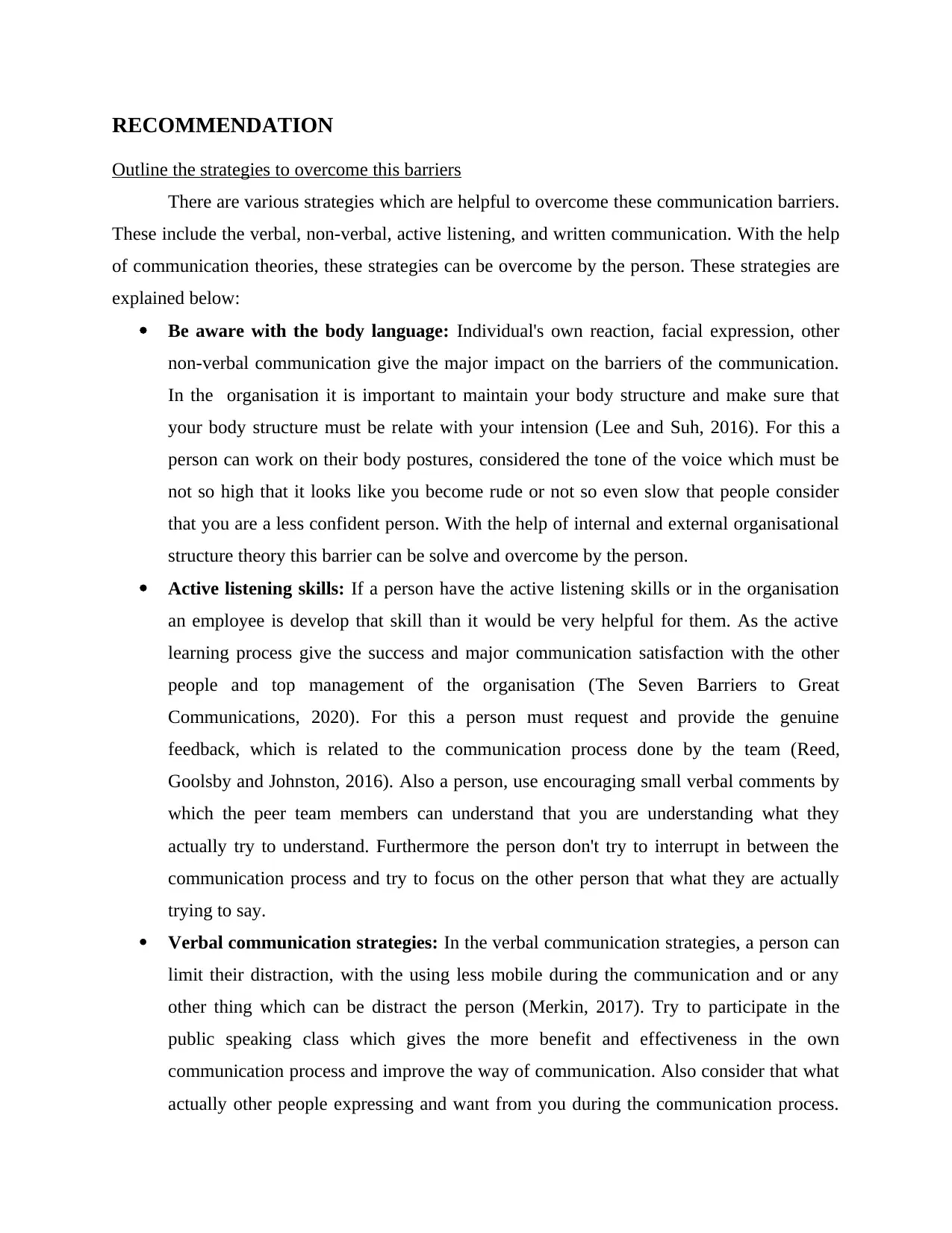
RECOMMENDATION
Outline the strategies to overcome this barriers
There are various strategies which are helpful to overcome these communication barriers.
These include the verbal, non-verbal, active listening, and written communication. With the help
of communication theories, these strategies can be overcome by the person. These strategies are
explained below:
Be aware with the body language: Individual's own reaction, facial expression, other
non-verbal communication give the major impact on the barriers of the communication.
In the organisation it is important to maintain your body structure and make sure that
your body structure must be relate with your intension (Lee and Suh, 2016). For this a
person can work on their body postures, considered the tone of the voice which must be
not so high that it looks like you become rude or not so even slow that people consider
that you are a less confident person. With the help of internal and external organisational
structure theory this barrier can be solve and overcome by the person.
Active listening skills: If a person have the active listening skills or in the organisation
an employee is develop that skill than it would be very helpful for them. As the active
learning process give the success and major communication satisfaction with the other
people and top management of the organisation (The Seven Barriers to Great
Communications, 2020). For this a person must request and provide the genuine
feedback, which is related to the communication process done by the team (Reed,
Goolsby and Johnston, 2016). Also a person, use encouraging small verbal comments by
which the peer team members can understand that you are understanding what they
actually try to understand. Furthermore the person don't try to interrupt in between the
communication process and try to focus on the other person that what they are actually
trying to say.
Verbal communication strategies: In the verbal communication strategies, a person can
limit their distraction, with the using less mobile during the communication and or any
other thing which can be distract the person (Merkin, 2017). Try to participate in the
public speaking class which gives the more benefit and effectiveness in the own
communication process and improve the way of communication. Also consider that what
actually other people expressing and want from you during the communication process.
Outline the strategies to overcome this barriers
There are various strategies which are helpful to overcome these communication barriers.
These include the verbal, non-verbal, active listening, and written communication. With the help
of communication theories, these strategies can be overcome by the person. These strategies are
explained below:
Be aware with the body language: Individual's own reaction, facial expression, other
non-verbal communication give the major impact on the barriers of the communication.
In the organisation it is important to maintain your body structure and make sure that
your body structure must be relate with your intension (Lee and Suh, 2016). For this a
person can work on their body postures, considered the tone of the voice which must be
not so high that it looks like you become rude or not so even slow that people consider
that you are a less confident person. With the help of internal and external organisational
structure theory this barrier can be solve and overcome by the person.
Active listening skills: If a person have the active listening skills or in the organisation
an employee is develop that skill than it would be very helpful for them. As the active
learning process give the success and major communication satisfaction with the other
people and top management of the organisation (The Seven Barriers to Great
Communications, 2020). For this a person must request and provide the genuine
feedback, which is related to the communication process done by the team (Reed,
Goolsby and Johnston, 2016). Also a person, use encouraging small verbal comments by
which the peer team members can understand that you are understanding what they
actually try to understand. Furthermore the person don't try to interrupt in between the
communication process and try to focus on the other person that what they are actually
trying to say.
Verbal communication strategies: In the verbal communication strategies, a person can
limit their distraction, with the using less mobile during the communication and or any
other thing which can be distract the person (Merkin, 2017). Try to participate in the
public speaking class which gives the more benefit and effectiveness in the own
communication process and improve the way of communication. Also consider that what
actually other people expressing and want from you during the communication process.
Paraphrase This Document
Need a fresh take? Get an instant paraphrase of this document with our AI Paraphraser
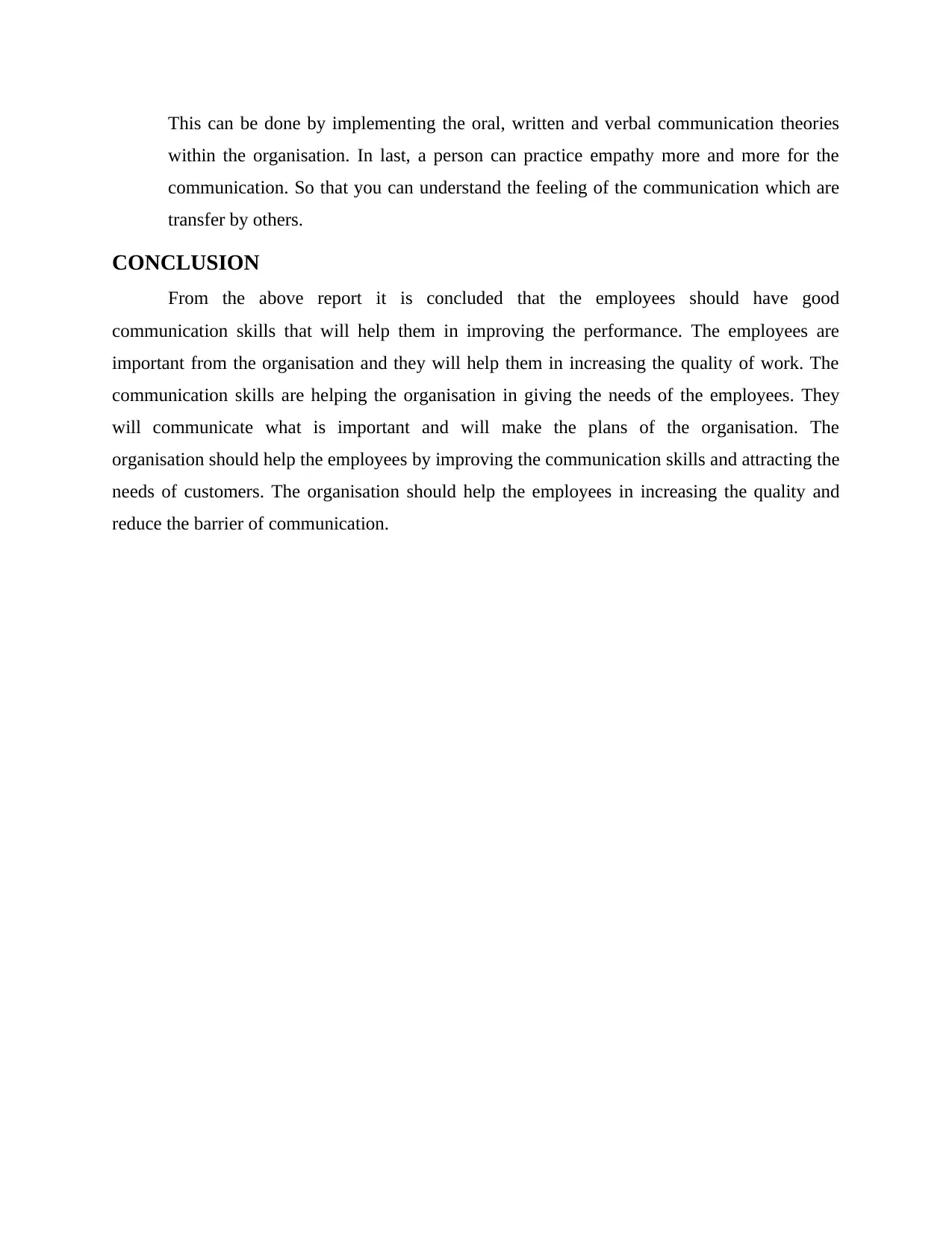
This can be done by implementing the oral, written and verbal communication theories
within the organisation. In last, a person can practice empathy more and more for the
communication. So that you can understand the feeling of the communication which are
transfer by others.
CONCLUSION
From the above report it is concluded that the employees should have good
communication skills that will help them in improving the performance. The employees are
important from the organisation and they will help them in increasing the quality of work. The
communication skills are helping the organisation in giving the needs of the employees. They
will communicate what is important and will make the plans of the organisation. The
organisation should help the employees by improving the communication skills and attracting the
needs of customers. The organisation should help the employees in increasing the quality and
reduce the barrier of communication.
within the organisation. In last, a person can practice empathy more and more for the
communication. So that you can understand the feeling of the communication which are
transfer by others.
CONCLUSION
From the above report it is concluded that the employees should have good
communication skills that will help them in improving the performance. The employees are
important from the organisation and they will help them in increasing the quality of work. The
communication skills are helping the organisation in giving the needs of the employees. They
will communicate what is important and will make the plans of the organisation. The
organisation should help the employees by improving the communication skills and attracting the
needs of customers. The organisation should help the employees in increasing the quality and
reduce the barrier of communication.
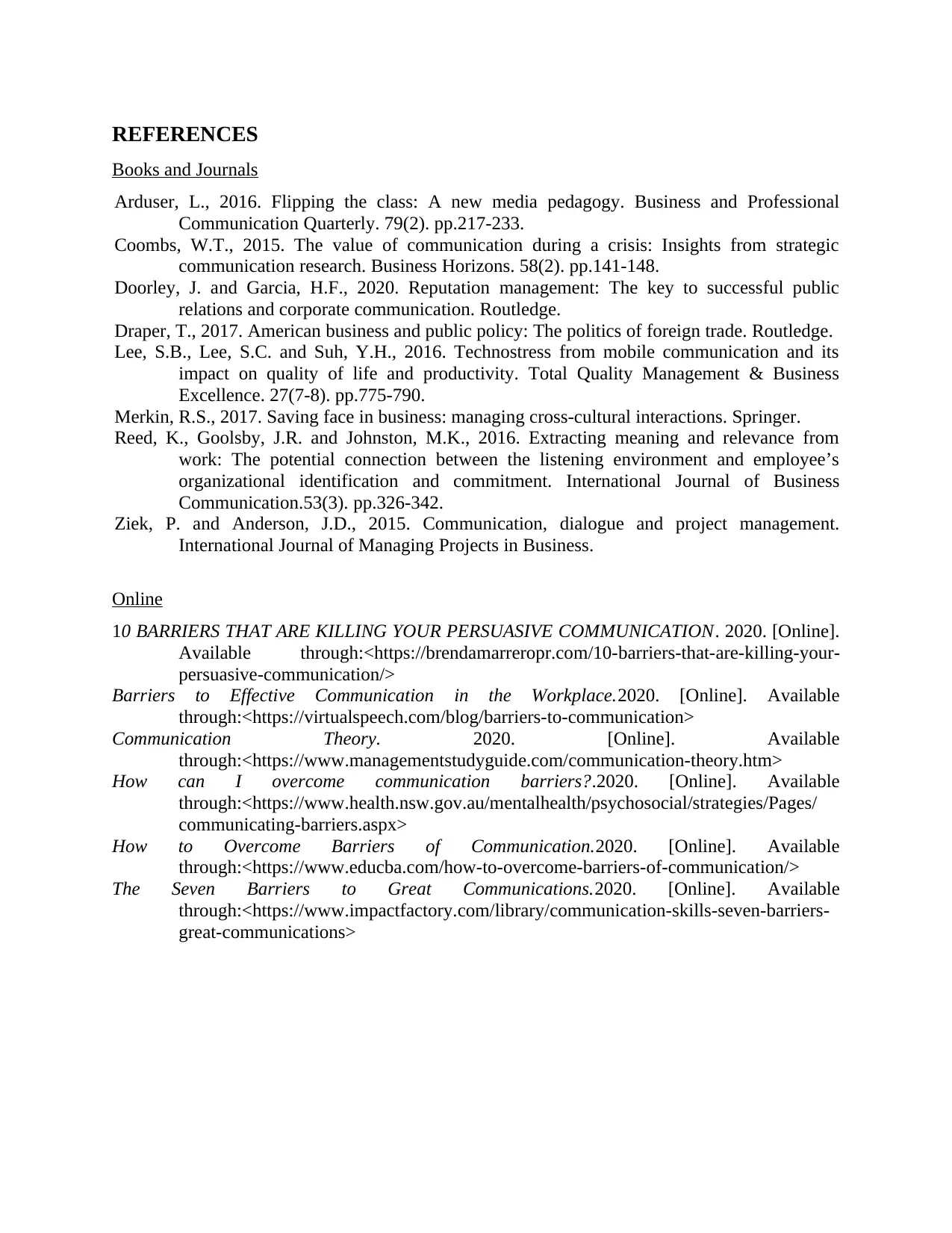
REFERENCES
Books and Journals
Arduser, L., 2016. Flipping the class: A new media pedagogy. Business and Professional
Communication Quarterly. 79(2). pp.217-233.
Coombs, W.T., 2015. The value of communication during a crisis: Insights from strategic
communication research. Business Horizons. 58(2). pp.141-148.
Doorley, J. and Garcia, H.F., 2020. Reputation management: The key to successful public
relations and corporate communication. Routledge.
Draper, T., 2017. American business and public policy: The politics of foreign trade. Routledge.
Lee, S.B., Lee, S.C. and Suh, Y.H., 2016. Technostress from mobile communication and its
impact on quality of life and productivity. Total Quality Management & Business
Excellence. 27(7-8). pp.775-790.
Merkin, R.S., 2017. Saving face in business: managing cross-cultural interactions. Springer.
Reed, K., Goolsby, J.R. and Johnston, M.K., 2016. Extracting meaning and relevance from
work: The potential connection between the listening environment and employee’s
organizational identification and commitment. International Journal of Business
Communication.53(3). pp.326-342.
Ziek, P. and Anderson, J.D., 2015. Communication, dialogue and project management.
International Journal of Managing Projects in Business.
Online
10 BARRIERS THAT ARE KILLING YOUR PERSUASIVE COMMUNICATION. 2020. [Online].
Available through:<https://brendamarreropr.com/10-barriers-that-are-killing-your-
persuasive-communication/>
Barriers to Effective Communication in the Workplace.2020. [Online]. Available
through:<https://virtualspeech.com/blog/barriers-to-communication>
Communication Theory. 2020. [Online]. Available
through:<https://www.managementstudyguide.com/communication-theory.htm>
How can I overcome communication barriers?.2020. [Online]. Available
through:<https://www.health.nsw.gov.au/mentalhealth/psychosocial/strategies/Pages/
communicating-barriers.aspx>
How to Overcome Barriers of Communication.2020. [Online]. Available
through:<https://www.educba.com/how-to-overcome-barriers-of-communication/>
The Seven Barriers to Great Communications.2020. [Online]. Available
through:<https://www.impactfactory.com/library/communication-skills-seven-barriers-
great-communications>
Books and Journals
Arduser, L., 2016. Flipping the class: A new media pedagogy. Business and Professional
Communication Quarterly. 79(2). pp.217-233.
Coombs, W.T., 2015. The value of communication during a crisis: Insights from strategic
communication research. Business Horizons. 58(2). pp.141-148.
Doorley, J. and Garcia, H.F., 2020. Reputation management: The key to successful public
relations and corporate communication. Routledge.
Draper, T., 2017. American business and public policy: The politics of foreign trade. Routledge.
Lee, S.B., Lee, S.C. and Suh, Y.H., 2016. Technostress from mobile communication and its
impact on quality of life and productivity. Total Quality Management & Business
Excellence. 27(7-8). pp.775-790.
Merkin, R.S., 2017. Saving face in business: managing cross-cultural interactions. Springer.
Reed, K., Goolsby, J.R. and Johnston, M.K., 2016. Extracting meaning and relevance from
work: The potential connection between the listening environment and employee’s
organizational identification and commitment. International Journal of Business
Communication.53(3). pp.326-342.
Ziek, P. and Anderson, J.D., 2015. Communication, dialogue and project management.
International Journal of Managing Projects in Business.
Online
10 BARRIERS THAT ARE KILLING YOUR PERSUASIVE COMMUNICATION. 2020. [Online].
Available through:<https://brendamarreropr.com/10-barriers-that-are-killing-your-
persuasive-communication/>
Barriers to Effective Communication in the Workplace.2020. [Online]. Available
through:<https://virtualspeech.com/blog/barriers-to-communication>
Communication Theory. 2020. [Online]. Available
through:<https://www.managementstudyguide.com/communication-theory.htm>
How can I overcome communication barriers?.2020. [Online]. Available
through:<https://www.health.nsw.gov.au/mentalhealth/psychosocial/strategies/Pages/
communicating-barriers.aspx>
How to Overcome Barriers of Communication.2020. [Online]. Available
through:<https://www.educba.com/how-to-overcome-barriers-of-communication/>
The Seven Barriers to Great Communications.2020. [Online]. Available
through:<https://www.impactfactory.com/library/communication-skills-seven-barriers-
great-communications>
⊘ This is a preview!⊘
Do you want full access?
Subscribe today to unlock all pages.

Trusted by 1+ million students worldwide

1 out of 10
Related Documents
Your All-in-One AI-Powered Toolkit for Academic Success.
+13062052269
info@desklib.com
Available 24*7 on WhatsApp / Email
![[object Object]](/_next/static/media/star-bottom.7253800d.svg)
Unlock your academic potential
Copyright © 2020–2025 A2Z Services. All Rights Reserved. Developed and managed by ZUCOL.





